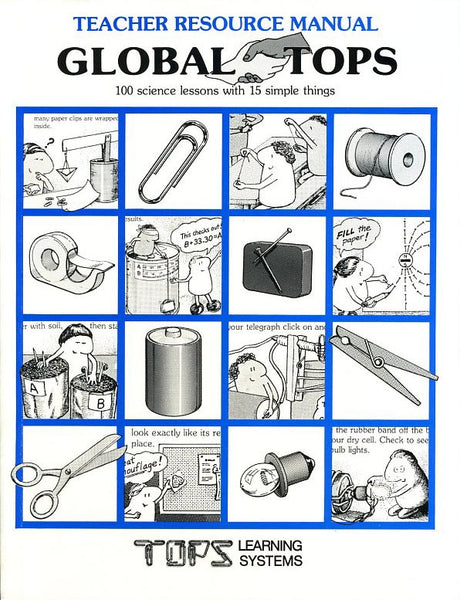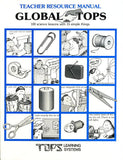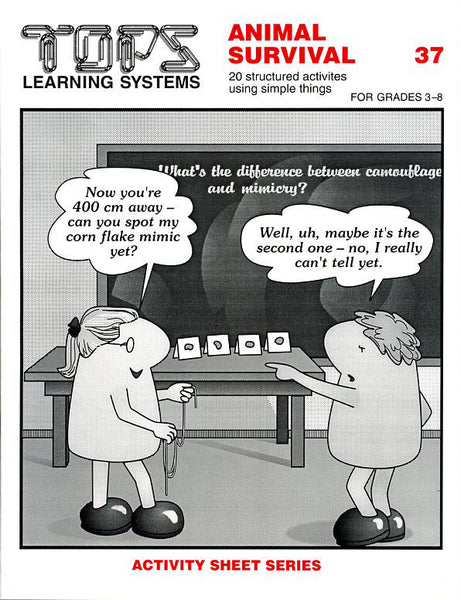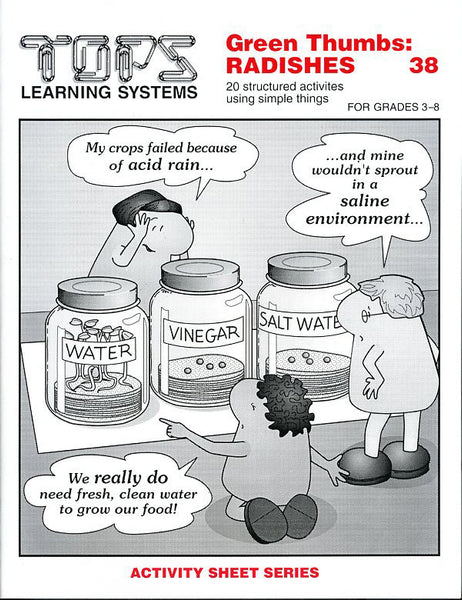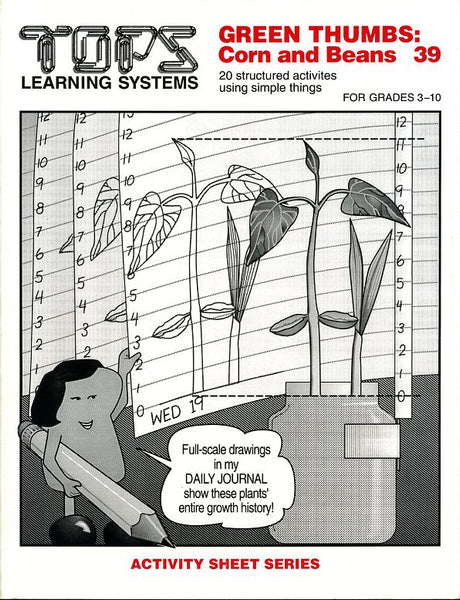#91 Global TOPS Resource Manual (grades 3-10)
Regular price $66.95
Perfect-bound, 272 page compilation, 100 reproducible activity sheets, full teaching notes.
Take a box of 15 basic materials anywhere in the world, add a few local recyclables, and teach an amazing range of hands-on science. Topics compiled from books in our popular Activity Sheet series include balancing, electricity, magnetism, pendulums, metrics, animals and plants. No science background is assumed: these labs are supported by thorough, thoughtful user friendly teaching notes. At 67 cents per lesson, this compilation is thriftier than purchasing each book separately.
Click here for a complete list of materials and convenient shopping.
Gather these 15 basics plus recyclables to teach ALL 100 lessons in this book! Quantities are sufficient for 30 students working in 15 pairs. Starred* items may be purchased below.
Materials to Purchase
15 pair Scissors
* 11 boxes of Paper Clips
* 5 rolls of Masking Tape
* 120 medium-sized Rubber Bands
* 8 rolls Clear Tape
* 1 box steel Straight Pins
* 90 wooden spring-action Clothespins
* 2 rolls Aluminum Foil
* 60 size-D Batteries
* 40 Flashlight Bulbs
* 1 box fine-grade Steel Wool
* 70 small Ceramic Magnets
* 1 roll plastic-insulated Copper Wire
* 30 medium-sized Nails
Available and Recycled Materials
1 Wall Clock with second hand sweep (or substitute wristwatches)
30 small Coins (pennies) of uniform size
15 Hand Calculators
30 medium-sized Cans
1 small package each of Pinto Beans, Popcorn, Lentils and long-grained Rice (or locally available seeds)
* 15 Bottle Caps
15 Pen Caps
1 handful of Scratch Paper
1 Water Source
* 30 small glass Jars with Lids.
15 large glass Jars
1 package Table Sugar (used in one activity)
1 package Table Salt (used in one activity)
local Insects and Animals to observe
1 ball String
various Paints, Crayons, or Colored Pencils
1 handful Newspaper
1 small bag Potting Soil
1 roll Plastic Wrap
School Supplies
1 Notebook or supply of notebook paper
1 Pencil
1 Eraser
- A. INVESTIGATING PENDULUMS
- 1. To observe a pendulum and describe its motion. To understand, in qualitative terms, how the frequency of a pendulum changes with length.
- 2. To make a pendulum that ticks out time like a clock -- 60 cycles per minute.
- 3. To determine if changes in bob weight affect the frequency of a pendulum.
- 4. To determine if changes in amplitude affect the frequency of a pendulum.
- 5. To understand why the length of a pendulum must be measured from the pivot to the center of the bob.
- 6. To observe energy transfers in coupled pendulums of equal and unequal length. To appreciate that a pendulum optimally accepts energy when it is delivered in phase with its natural frequency.
- 7. To observe energy transfers between pendulums that wind around each other. To predict how this motion changes as you make one pendulum longer than the other.
- B. PENDULUM MATHEMATICS
- 1. To find the frequency of a 5 cm, 6 cm and 7 cm pendulum. To discover a short-cut method for determining frequency.
- 2. To discover a squared relationship between pendulum frequency and length. To apply this relationship in a predictive way.
- 3. To graph pendulum frequency as a function of length. To read and interpret the resulting graph.
- 4. To mathematically predict the frequency of paper-clip chains. To confirm these predictions by experiment.
- 5. To graph how the frequency of a paper-clip chain varies with length.
- 6. To calculate the square root of two, first by using pendulum ratios, then by using simple geometry.
- 7. To graph how the weight of the bob affects amplitude decay in a pendulum.
- C. BALANCE BEAMS
- 1. To fold a paper beam to use in a math balance.
- 2. To complete construction of the math balance.
- 3. To get acquainted with a math beam. To diagram various ways that paper clips can balance on the beam.
- 4. To understand that paper clips add up to equal sums on each arm of a balanced beam.
- 5. To understand that paper clips multiply to equal products on each arm of a balanced beam.
- 6. To understand the mathematics of balancing. To gain further experience with balance beams.
- 7. To practice expressing complex balance combinations as mathematical equations.
- 8. To mathematically predict and then verify a state of balance or imbalance on a math beam.
- 9. To mathematically predict and then verify whether a balance beam tilts left, right, or remains level.
- D. COMPARING MASSES
- 1. To fold a paper beam to use in an equal-arm balance.
- 2. To complete construction of an equal-arm balance.
- 3. To make mass comparisons on a balance beam and thereby generate simple mathematical relationships.
- 4. To find the mass of common classroom objects using a paper-clip standard of measure.
- 5. To find the mass of common classroom objects using a mass standard refined to a tenth of a paper clip.
- 6. To count an unknown quantity of paper clips by comparing their mass to a known number of paper clips on a balance.
- 7. To develop a series of gram masses to use with the equal arm balance.
- 8. To graph how the total mass of paper clips increases in direct proportion to their total numbers.
- 9. To convert from paper clip units of mass to standard gram units. To compare calculated mass values with experimental values.
- 10. To graph how the mass of seeds increases in direct proportion to their numbers. To understand slope as a function of seed size.
- E. DIFFERENT DIMENSIONS
- 1. To measure distance with a metric ruler. To recognize the metric cube as a basic unit of metric expression.
- 2. To develop a concrete understanding of area. To learn how to calculate area and express it as squared measure.
- 3. To develop a concrete understanding of volume. To learn how to calculate volume and express it as cubed measure.
- 4. To measure a box in one, two, and three dimensions. To distinguish between length, area and volume.
- 5. To develop a metric volume standard for measuring out small amounts of water.
- 6. To find volumes using liquid measure. To calibrate a glass jar at the 100 mL level.
- 7. To distinguish between 5 different units of measure.
- 8. To find the volume of a can using different instruments of liquid measure. To calibrate a jar in 100mL increments up to 1 liter.
- 9. To estimate the number of seeds in a can by comparing volumes.
- 10. To correlate the mass of a substance with its floating and sinking characteristics.
- F. TALKING METRIC
- 1. To understand the language of metric prefixes. To learn how to make metric conversions by moving the decimal point.
- 2. To estimate large numbers. To understand metric multiples in concrete terms.
- 3. To visualize how metric units fit together as multiples of 10. To practice expressing one measure in terms of another.
- 4. To become familiar with 42 important interrelated facts about metric volume, mass, and length.
- 5. To firmly link metric units with common conversion factors and concrete images.
- 6. To memorize metric relationships in a fun way.
- G. SIGNIFICANT FIGURES
- 1. To learn how to read a ruler accurately, estimating the last digit.
- 2. To distinguish between certain figures and uncertain figures. To appreciate that no measurement is exact.
- 3. To practice reading a hairline (in significant figures) that crosses rulers calibrated in centimeters and millimeters.
- 4. To practice measuring accurately with a ruler. To recognize that estimating is always necessary, no matter how accurate the ruler.
- 5. To practice measuring physical objects with a meter tape. To estimate the last digit.
- 6. To discover basic body proportions by making accurate measurements with a meter tape. To appreciate that body units of measure are not standard.
- H. BULBS AND BATTERIES
- 1. To discover by trial and error how to light a bulb with a dry cell and ribbon.
- 2. To further explore by trial and error the different ways to light a bulb with dry cell and ribbon.
- 3. To use the idea of contact points to predict if a bulb will light. To test these predictions by experiment.
- 4. To learn how to connect cells in series and opposition. To understand how this affects bulb brightness.
- 5. To learn how to connect cells in parallel. To understand how this affects bulb brightness.
- 6. To use a bulb and dry cell to test whether common materials in the classroom are conductors or insulators.
- 7. To construct a circuit puzzle. To find by trial and error those holes that are connected and those that are not.
- I. CIRCUITS
- 1. To make a bulb holder and dry cell holder to use in later activities.
- 2. To make a switch and integrate it into a simple circuit. To study how alternate pathways around the bulb and switch affect a simple circuit.
- 3. To learn how to draw simple circuit diagrams using accepted symbols. To predict how electrons flow through these circuits.
- 4. To practice mapping and drawing more complicated circuit diagrams. To predict how electrons flow through these circuits.
- 5. To learn how to connect dry cells to achieve maximum brightness.
- 6. To understand why electricians wire buildings in parallel, rather than in series.
- 7. To build 2-way switches and integrate them into a circuit. To understand how they work.
- J. ELECTRICAL RESISTANCE
- 1. To understand how length and diameter affect electrical resistance in wire.
- 2. To watch a miniature fireworks show! To appreciate that high electrical resistance creates heat and light.
- 3. To appreciate that the flow of electricity decreases with increased resistance.
- 4. To understand how fuses work to protect circuits from shorts and overloads.
- K. MAGNETS
- 1. To recognize that only a few metals, like iron and steel, are attracted by a magnet.
- 2. To identify, then label, the north and south poles on unmarked magnets by using the Earth's magnetic field as a reference.
- 3. To observe interactions between rotating magnetic fields.
- 4. To observe that a magnetic field passes unchanged through solid objects unless they are magnetic.
- 5. To graph how the strength of a magnet decreases with increased distance from the magnet.
- L. MAGNETIC FIELDS
- 1. To build a pin compass and observe how it works.
- 2. To practice finding directions with a compass.
- 3. To practice using a compass to determine directions between reference points in the classroom.
- 4. To map the shape of a magnetic field that surrounds a magnet.
- 5. To map the shape of two interacting magnetic fields that attract.
- 6. To map the shape of two interacting magnetic fields that repel.
- M. INVENTIONS
- 1. To learn how to construct and use an electromagnet. To appreciate that electromagnets are temporary, working only as electricity passes through the coil.
- 2. To build two simplified models of an electric motor. To understand how they work.
- 3. To build a working model of a telegraph. To understand how it works.
- 4. To build a working model of a buzzer. To understand how it works.
- 5. To build an on-off motor that spins by bouncing.
- N. ANIMALS
- 1. To observe similarities and differences between yourself and another animal.
- 2. To provide a generalized form useful for observing a diversity of animal life, both in and out of the classroom. To understand the distinction between an observation and an hypothesis.
- 3. To appreciate how each body part helps a bird survive in its own particular environment.
- 4. To camouflage paper moths so they blend into the patterns and textures of classroom surfaces.
- 5. To examine speed, endurance, and camouflage as survival techniques. To consider the trade-offs.
- 6. To recall many different ways that animals survive. To relate animal survival strategies to variations in habitat.
- O. PLANTS
- 1. To compare and contrast two kinds of seeds in words and pictures. To sprout these seeds in a warm, moist environment.
- 2. To study the effects of light and darkness on the germination and growth of seeds.
- 3. To construct an inexpensive, low-maintenance, space-conserving system for growing plants.
- 4. To record in words and pictures the daily development and growth of germinating seeds.
- 5. To accurately track the growth of seedlings over 3 weekly intervals on a drawing grid.
TEACHING Standards
These 100 activity sheets promote excellence in science teaching by these NSES criteria:
Teachers of science...
A: ...plan an inquiry-based science program. (p. 30)
B: ...guide and facilitate learning. (p. 32)
C: ...engage in ongoing assessment of their teaching and of student learning. (p. 37)
D: ...design and manage learning environments that provide students with the time, space, and resources needed for learning science. (p. 43)
CONTENT Standards
These 100 activity sheets contain fundamental content as defined by these NSES guidelines (p. 109).
• Represent a central event or phenomenon in the natural world.
• Represent a central scientific idea and organizing principle.
• Have rich explanatory power.
• Guide fruitful investigations.
• Apply to situations and contexts common to everyday experiences.
• Can be linked to meaningful learning experiences.
• Are developmentally appropriate for students at the grade level specified.
Unifying Concepts and Processes
NSES Framework: Systems, order, and organization • Evidence, models and explanation • Constancy, change, and measurement • Evolution and equilibrium • Form and function
Core Concepts/Processes: Interdisciplinary integrative studies organize around 15 everyday materials plus common recyclables.
Science as Inquiry (content standard A)
NSES Framework: Identify questions that can be answered through scientific investigations. • Design and conduct a scientific investigation. • Use appropriate tools and techniques to gather, analyze, and interpret data. • Develop descriptions, explanations, predictions, and models using evidence. • Think critically and logically to connect evidence and explanations. • Recognize and analyze alternative explanations and predictions. • Communicate scientific procedures and explanations. • Use mathematics in all aspects of scientific inquiry.
Core Inquiries: Fifteen simple materials (paper clips, masking tape, clothespins and such), drive 100 lessons.
Physical Science (content standard B)
NSES Framework: Position and motion of objects • Light, heat, electricity, and magnetism • Properties and changes of properties in matter • Motions and forces • Transfer of energy • Interactions of energy and matter
Core Content: Pendulums • Electricity • Magnetism • Balance-beams • Comparing masses • Length, area and volume • Dry and liquid measure • Metric system logic • Significant figures
Life Science (content standard C)
NSES Framework: Structure and function in living systems • Organisms and environments • Behavior of organisms
Core Content: Observation of plants and animals • Adaptations • Camouflage • Seed germination • Variables affecting growing and development.
Science and Technology (content standard E)
NSES Framework: Abilities of technological design • Understanding about science and technology
Core Content: You don't need fancy equipment to teach solid science. Just improvise! Fifteen everyday materials drive 100 hands-on, minds-on experiments.
Science in Personal and Social Perspectives (content standard F)
NSES Framework: Science and technology in local challenge • Science and technology in local, national and global challenges
Core Content: Take your science 'supply room' with you, in a box under your arm, anywhere in the world. • Teach hands-on science and math anywhere in the world with few educational or lab resources.

